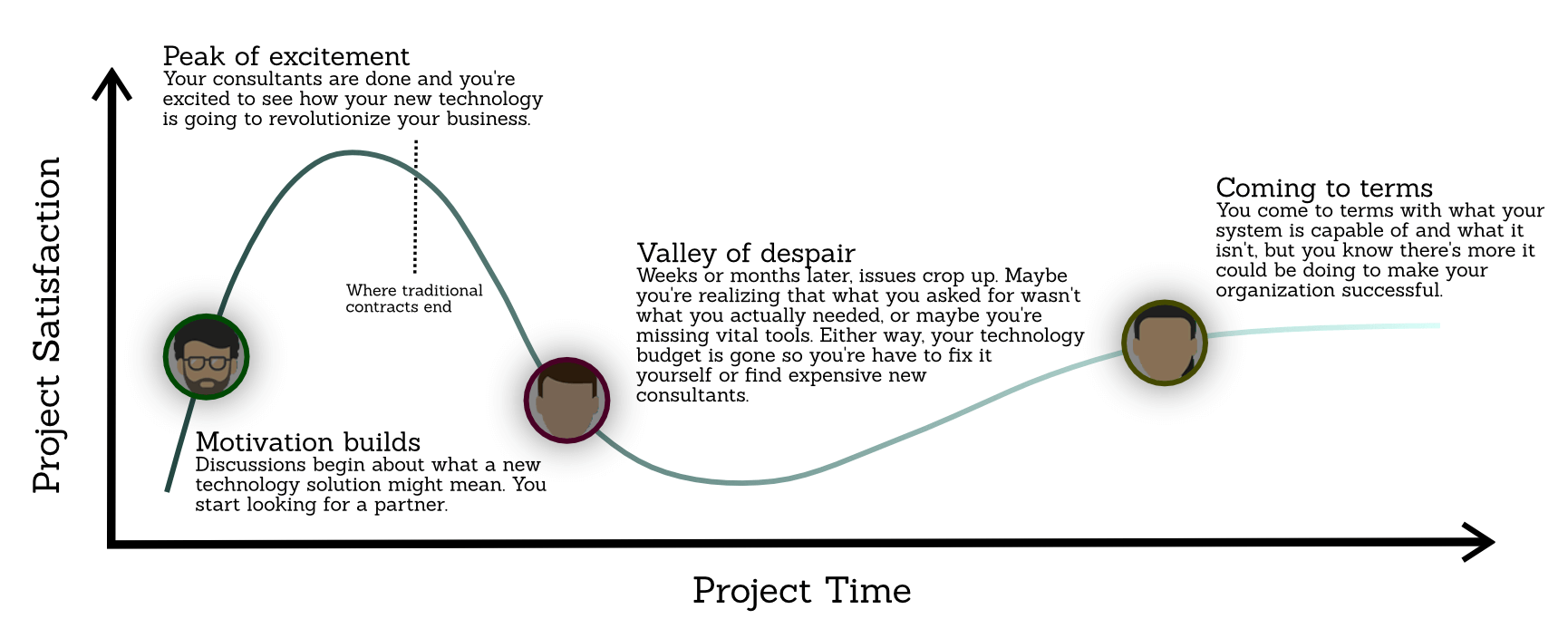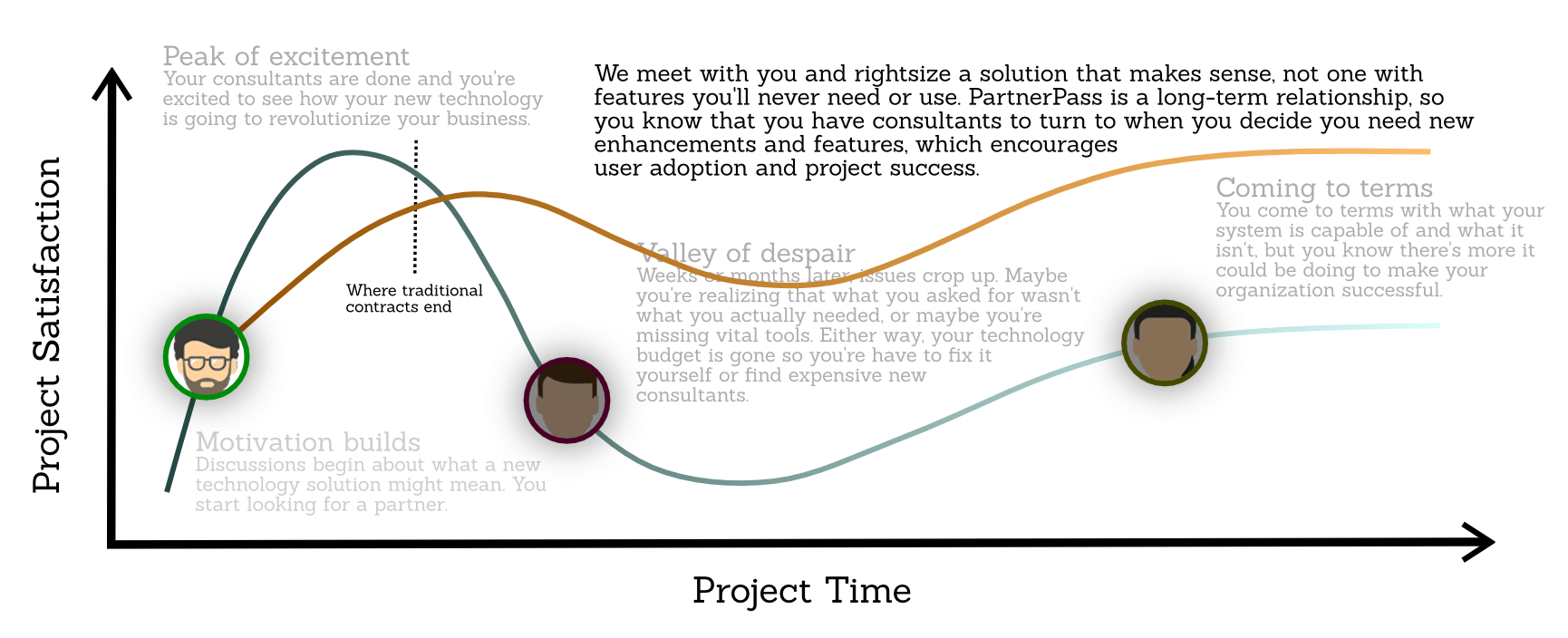This is the second post in a short series on the models of engagement available to SMBs (check out the first here). In it you’ll learn how our new PartnerPass subscription consulting-as-a-service program fits into this ecosystem and discover why it may be the perfect choice for your organization.
One of the most difficult, important aspects of management is handling change. Organization change can be motivated by internal or external factors, but one prominent, recurring aspect is the tendency for organizations undergoing change to follow the initial, enthusiastic honeymoon phase with a frustrating period of inefficiency and low morale. This is referred to by a number of names, including the “valley of despair”.
Organizations only rebound once all parties understand and are engaged in ‘solving’ the issue. That’s assuming, of course, that all parties are able to come together with a positive agreement rather than canceling whatever program the change was associated with.
This concept certainly applies when organizations undergo major business system upgrades and implementations. Even a well-designed CRM implementation (with custom targeted fields, well designed interfaces and industry specific adaptations) necessitates a redesigned workflow, which can cause confusion and result in poor adoption.

A Look at the Project Lifecycle, Including the Valley of Despair
In this post we’ll examine how quick start and subscription consultative programs (check out the first post in this series to learn more about these services) are equipped to deal with and mitigate the negative effects of organization change, and whether that presents enough of an issue to be a factor when choosing an implementation partner.
Can Quick Start Programs Ensure Long Term Success?
Because business technology services have such a large impact on operations, it can take weeks or months for issues to become apparent. This is where the biggest flaw with quick start CRM initiatives becomes apparent. They deliver a reasonably company specific implementation within a specific period of time, but the delivery period is only a small section of the project lifecycle.
Quick start packages are affordable for a reason – they end around the peak of the honeymoon phase, when company leadership is dreaming of where their new CRM, for example, is going to take them. They typically provide only a little in the way of long term support or training without signing a new contract, which is expensive enough that it negates the cost benefit of using a quick start in the first place.
There are a number of reasons that a valley of despair is essentially inevitable in a new implementation, many of which are exacerbated by the very things that define quick start solutions. Even talented consultants with industry experience are unlikely to know exactly what fields, configurations and customizations are necessary for a specific business’s workflow. It might take at least a month or more for the organization to realize that they lack certain functionality, by which time the quick start consultants are no longer able to make changes.
The way quick start programs force clients to arrange their budget can also cause problems. Because they promise a fully featured, finished product, customers can be willing to spend a significant portion of their budget on the initial project. This leaves little left over to fix issues and incompatibilities that arise in the following weeks and months, which means that organizations are forced to make tough decisions about their priorities.
Building Support for Any Point in the Project Lifecycle
Subscription consultative relationships, on the other hand, take an approach that shows a greater appreciation for the totality of the project lifecycle. Rather than spend a significant amount upfront on a complete system, the idea is to put together a suitable initial implementation in collaboration with customer stakeholders, then iterate over time.

Consultative Subscription Programs Like PartnerPass Build for Long Term Success
This eliminates the issues that arise when organizations realize that their complete solutions don’t support particular business cases or features (or support them in an inefficient manner). Instead, customers get a right-sized initial system and can plan for enhancements when they’re sure that they’re an effective use of time and resources.
A solution that’s built more gradually can also be easier for users to adapt to, as they have fewer features to take advantage of and be confused by. Once users have a grasp of the tools available, more can be added, which helps insure user satisfaction and adoption.
At first glance, the downside to a collaborative subscription relationship is its cost. A twelve-month agreement at $2,500 a month (for an annual price of $30,000) seems like a significant financial obligation compared to a $15,000 upfront investment. The $30,000, however, pays for itself in different ways.
For one, subscription consultative relationships include time built in to the subscription that can be used for training and support purposes when necessary, which obviates the need for a support specific arrangement. It also means that new features can be added smoothly throughout the partnership, rather than requiring companies to sign expensive new contracts to add specific features. A long term payment structure means that companies can avoid big upfront payments and plan their technology budget throughout the year.
A long term relationship also means that consultants and clients get to know and understand each other, which helps consultants align their client’s business systems with their growth and goals as a company. This means that every addition can be targeted to increase the organization’s efficiency, tackle specific issues and help increase their growth potential, rather than adding features based on a checklist of industry specific customizations which may never prove useful.
In the worst cases, the valley of despair can be so debilitating for organizations that they are forced to write off projects entirely, which means that they lose out on their new solution and the money spent building it. While a consultative relationship can’t possibly mitigate every issue or ensure that companies are always happy with their technology, it plays a huge role in minimizing the downward effects of the valley of despair and offers a lifeline out.
